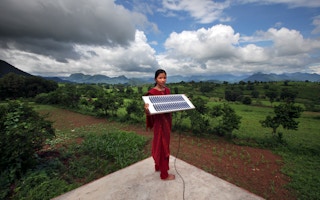Wind and solar generated a record 10 per cent of last year—more than twice the share compared to 2015, according to London-based climate and energy think tank Ember.
To continue reading, subscribe to Eco‑Business.
There's something for everyone. We offer a range of subscription plans.
- Access our stories and receive our Insights Weekly newsletter with the free EB Member plan.
- Unlock unlimited access to our content and archive with EB Circle.
- Publish your content with EB Premium.
The study found that, for the first time, wind and solar energy contributed to more than 10 per cent of energy supply in Asia Pacific, including China, Japan, and Vietnam.
Australia and Vietnam shifted over 8 per cent of their total electricity generation from fossil fuels to wind and solar in the past two years.
Denmark and Uruguay sourced 40 per cent of their electricity from wind turbines and solar panels, leading the way on technology for high renewable grid integration.
Despite these clean energy sources growing faster than before, global carbon emissions from the power sector rose to record highs last year especially in Asia as the recovery from the pandemic boosted electricity demand and utilities burned more coal amid a gas crunch.
Emissions increased by 7 per cent in 2021—the biggest percentage rise since 2010.
Global energy demand jumped to 1,414 terawatt-hours (TWh), the equivalent of adding another India to the world’s electricity demand.
The need for energy soared especially in Asia where China had a 13 per cent greater demand in 2021 than two years ago—the highest in the region.
It’s coal generation rose by 9.5 per cent, the fastest rate in four decades.
India’s coal power generation jumped to 11 per cent, as with the Philippines and Pakistan, at 8 per cent each. Coal power in major economies like the United States, Europe and Japan strongly rebounded compared to 2020, but remained below 2019 levels.
Clean electricity simply was not deployed quickly enough to keep up with unprecedented demand growth, noted the study.
Gas became ten times more expensive last year, compared to coal which was just three times pricier, making the latter a more viable source of electricity, said Dave Jones, Ember’s global lead and primary author of the report.
He called the price rises for both gas and coal a “double reason for electricity systems to demand more clean electricity, because the economics have shifted so fundamentally.”
“
The process that will reshape the existing energy system has begun. This decade, [wind and solar] need to be deployed at lightning speed to reverse global emissions increases and tackle climate change.
Dave Jones, global lead, Ember
Even if coal and power emissions hit another all-time high, wind and solar are “able and expected” to provide the majority of clean electricity needed to phase out all fossil fuels, said Jones.
The International Energy Agency has warned that renewables need to overtake coal, the biggest source of man-made emissions, by 2026 to keep the world on track for net-zero emissions by 2050.
This means wind and solar need to sustain high growth rates to provide three-quarters of all new clean power to become 40 per cent of the world’s electricity by 2030, up from 10 per cent now, noted the study.
“Wind and solar have arrived,” said Jones. “The process that will reshape the existing energy system has begun. This decade they need to be deployed at lightning speed to reverse global emissions increases and tackle climate change.”
As the high gas prices continue into 2022, the gas crisis is interrupting Europe’s coal exit, but identifies a “paradigm shift” as new renewables replace gas instead of coal, the report said.
“With sustained high gas prices amid Russia’s war with Ukraine, there is a real risk of relapse into coal, threatening the global 1.5 degrees climate goal,” said Jones. “Clean electricity now needs to be built on a heroic scale. Leaders are only just waking up to the challenge of how quickly they need to move to 100 per cent clean electricity.”








